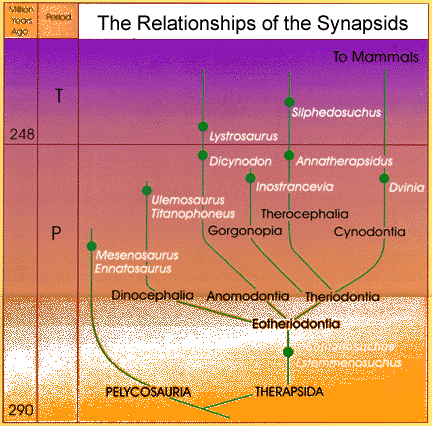
The
second group, synapsids ("single-arched"), is distinguished by the presence
of
one opening behind the eyesocket and one temporal arch.
The most primitive synapsids,
the pelycosaurs, beginning from the end of the
Carboniferous Period, became most
diverse in the Early Permian of North America.
In the Late Permian of East Europe
very few representatives of the pelycosaurs are
known, and among them are Ennatosaurus
and Mesenosaurus.
Very diverse advanced synapsids,
the therapsids ("beast-arched"), inhabited all the
continents in the
Late Permian, but only few survived in the Triassic.
These animals are the ancestors
of mammals. In the end of the Paleozoic Era, the
therapsids dominated the fauna
of terrestrial vertebrates in both the southern
continent, Gondwana, and the northern
one, Laurasia.
The richest records of therapsids have been collected in the Permian
depositions
of East Europe. The most ancient forms come from the early Late Permian
and
belong to the eotheriodonts ("early beast-toothed").
In the "Russian
Dinosaur Exposition" they are represented by both a predatory form (Eotitanosuchus),
and a huge herbivorous one (Estemmenosuchus).
Descendants
of the theriodonts have formed several large groups.
Dinocephalia ("horrible-headed"),
distinguished by an extraordinary
thickened skull roof, replaced the eotheriodonts
till the middle Late Permian.
Like the eotheriodonts, the dinocephalians created
both large predatory forms (Titanophoneus) and large
herbivorous forms (Ulemosaurus).
Anomodontia ("abnormal-toothed")
lived at the same time as the dinocephalians.
The advanced representatives of
the anomodonts, the dicynodonts ("double-fanged") have only two very large
fangs in the upper jaw.
All known anomodonts are herbivores (Dicynodon,
Lystrosaurus).
The principal therapsid group is the
theriodonts ("beast-toothed").
In the exhibition, they are represented
by the large predator Inostrancevia and two
therocephals
("beast-headed"): ichthyvorous Annatherapsidus
and small insectivorous
Silphedosuchus. The most evolutionarily
important are advanced theriodonts, the cynodonts ("dogtoothed"), represented
in the exhibition by Dvinia.
Cynodonts are related
most closely to the primitive mammals.
These two groups share many common features,
in partivular, broadened teeth with
a number of cusps, suitable for chewing a
food, and the development of
a bony palate, separating the respiratory tract from
the mouth cavity.
Possibly, the theriodonts were also covered by a primitive fur
that could
prevent drying rather than provide insulation.
Moreover, the cynodots,
like mammals, probably possessed the diaphragmatic breath.
A specialization of
the jaw apparatus in the theriodonts "released"
some bones of the lower
jaw, which in strongly reduced and transformed
state make up the structure of
the middle ear in mammals.
But the most essential aspect in mammalian evolution
was a progressive development
of the brain that had already begun in some advanced
theriodonts.




